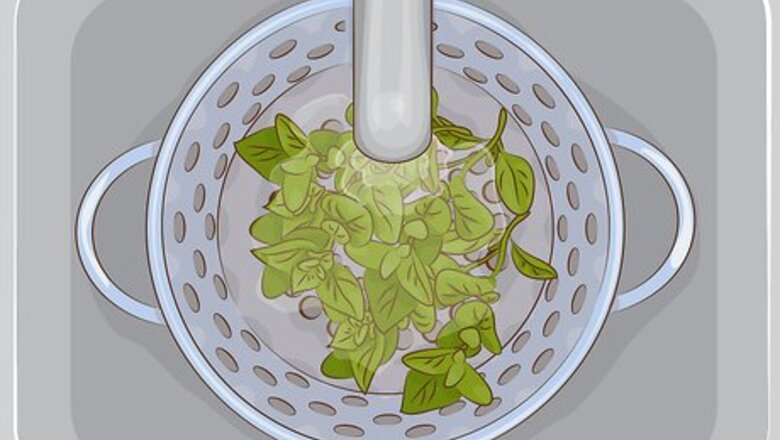
views
Chopping Fresh Oregano
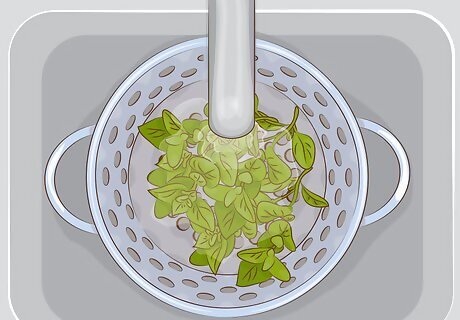
Wash the fresh herbs. Oregano leaves are small and are attached to a woody stem that isn't pleasant to eat. Transfer the herbs to a colander and rinse them under running water to remove dirt and other matter from the garden. Drain the herbs and transfer them to a clean tea towel. Pat the leaves dry.
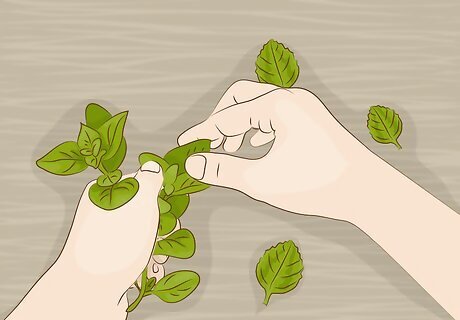
Remove the leaves from the stems. Take a single sprig of oregano and pinch the top of the stem between your thumb and finger. Run your fingers down the stem to strip the leaves from the stem. Repeat with the other sprigs. Instead of stripping the leaves from the stem, you can also trim the leaves off using scissors.
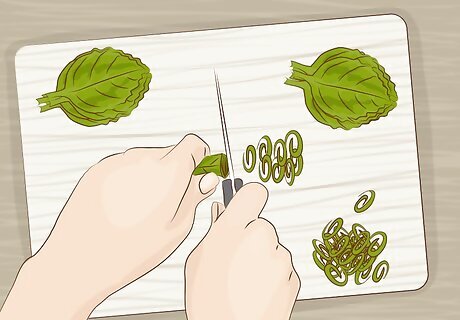
Stack and roll the leaves. Arrange the oregano leaves in piles of about 10, with the largest leaves on the bottom and the smaller leaves on top. One at a time, roll up each stack into a tight cylinder and hold it in place on a cutting board for chopping. Stacking, rolling, and chopping herbs like this is a cutting technique known as chiffonade, which produces long, thin strips.
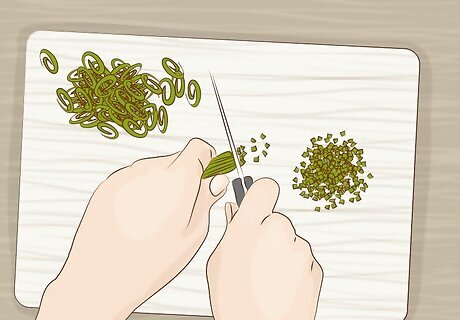
Mince the leaves. Use a sharp knife to slice thin strips off the roll of oregano leaves. This will produce long strips of the herb. Arrange these strips lengthwise on the cutting board, and then dice the strips into small flecks to add to cooking and baking.
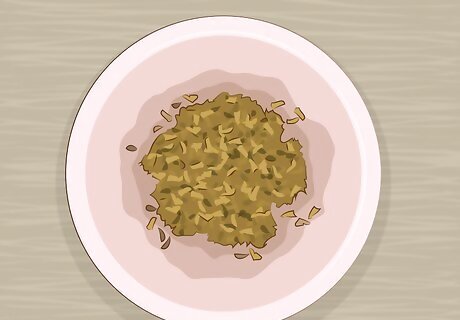
Try dried oregano in place of fresh. Instead of using fresh oregano in cooking and baking, you can also use dried oregano in its place. Dried oregano has a slightly stronger flavor, so you need less dried herb than you do fresh. Substitute 1 teaspoon (1.8 g) of dried oregano in place of 1 tablespoon (1.6 g) of fresh oregano. Dried oregano should be added to dishes at the beginning of the cooking time to ensure it has time to infuse into the other ingredients. Fresh oregano can be added near the end of the cooking process to help preserve more of its flavor.
Making Common Foods That Use Oregano
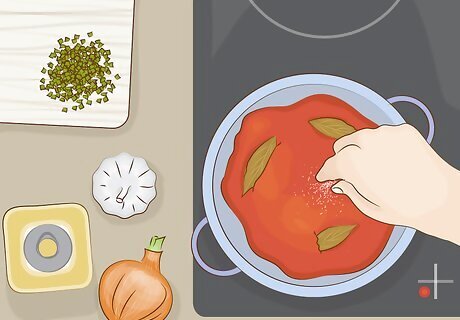
Make a simple tomato sauce. Oregano and tomato are a classic combination, and there are many tomato-based dishes that you can add oregano to. A basic tomato sauce is a great way to use oregano, because you can add the sauce to pasta, pizza, sandwiches, chilis, soups, and more. To make the sauce: In a large saucepan, cook a diced onion over medium heat with ¼ cup (59 ml) of olive oil, a bay leaf, 1 teaspoon (0.5 g) of fresh oregano, 2 cloves of minced garlic, and salt, to taste. Cook the mixture for 10 minutes. Add 2 tablespoons (28 g) of tomato paste and cook for another five minutes. Add two 28-ounce (794-g) cans of diced tomatoes and bring the mixture to a boil. When the sauce comes to a boil, lower the heat to medium-low and simmer it for an hour, stirring every few minutes. Remove the bay leaf and serve with your favorite dishes.

Make a Bolognese sauce. Bolognese sauce is a creamy meat-based tomato sauce that’s often served with spaghetti. Making Bolognese sauce is very similar to making a basic tomato sauce, except for the addition of some extra ingredients, which include: Celery Carrots Bacon or pancetta Veal Pork Whole milk White wine
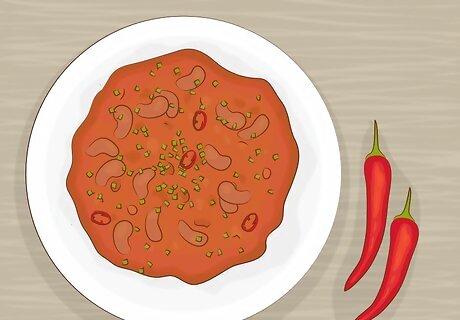
Add it to chili. Chili is another great tomato-based dish that you can add oregano to. Whether you prefer beef, turkey, or vegetarian chili, oregano always makes a great addition. You can either add 1 tablespoon (5.4 g) of dried oregano to the chili at the beginning of the cooking time, or add in 3 tablespoons (4.7 g) of fresh oregano to the pot in the last 15 minutes of cooking.
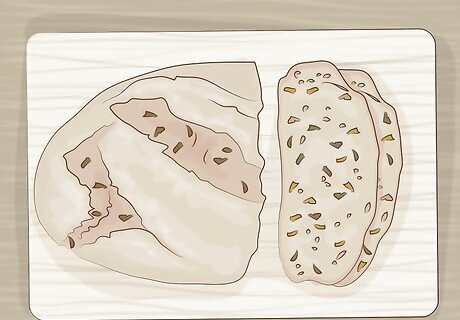
Add herbs to your breads and baked goods. Homemade herb breads are delicious and they make your house smell wonderful. Oregano is an excellent addition to baked goods, and next time you make your own bread, scones, or crackers, consider kneading a tablespoon (5.4 g) of dried oregano into the dough before baking. To make an Italian herb blend for breads and baked goods, combine 1 tablespoon (5.4 g) each of dried basil and oregano, 1 teaspoon (3 g) each of garlic and onion powder, and ½ cup (63 g) of grated Romano cheese.

Season your pizza. Because oregano goes so well with bread and tomato, it’s no surprise that pizza just doesn’t taste the same without this herb. You can add oregano to any pizza by using an oregano and tomato sauce, or you can sprinkle some fresh oregano right over the ingredients before baking the pizza.
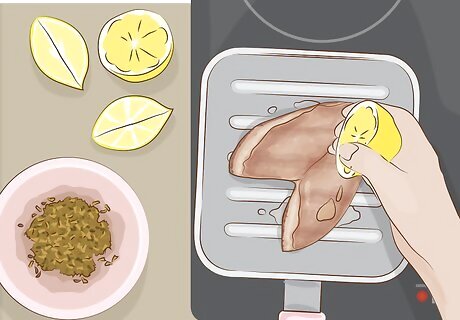
Bake chicken with lemon and oregano. Chicken and oregano is a classic combination, and nothing goes better with these two ingredients than lemon. You can cook chicken, oregano, and lemon together any way you like, including baking or grilling. To make baked lemon-oregano chicken: Combine in a small bowl ¼ cup (59 ml) of melted butter, ¼ cup (59 ml) of lemon juice, 2 tablespoons (30 ml) of Worcestershire sauce, and 2 tablespoons (30 ml) of soy sauce Transfer 6 skinless and boneless chicken breasts to a large baking dish Cover the chicken with the sauce Sprinkle 2 teaspoons (3.6 g) of dried oregano and 1 teaspoon (3 g) of garlic powder over the chicken Bake the chicken for 30 minutes in a 375 F (191 C) oven, pulling it out halfway through to baste the meat with the sauce
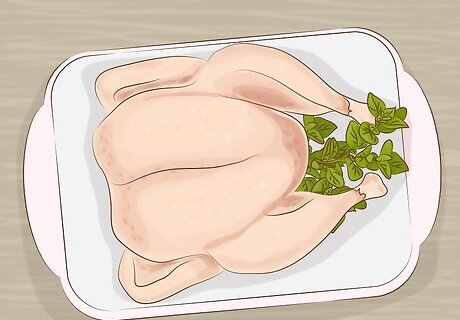
Season other meats and fish. You can also use oregano to season turkey, fish, beef, and other meats. For turkey, stuff the cavity with three or four sprigs of fresh oregano before baking. For fish, bake or grill the fish with one or two sprigs of fresh oregano, and remove the sprigs before serving. For beef, mix a tablespoon (1.6 g) of fresh oregano into 1 pound (454 g) of ground beef. Oregano-seasoned ground beef is ideal for meatballs and burgers.
Finding Other Culinary Uses for Oregano

Whip up an oregano pesto. Pesto is traditionally made with basil, but you can also make a fresh and tasty version with oregano. The pesto can be used as a spread, dip, pizza sauce, or even as a dressing for vegetables, salads, and potatoes. To make the pesto, pulse in a food processor until smooth: 1 cup (25 g) of fresh oregano ½ cup (63 g) of grated parmesan cheese 1 large garlic clove ½ cup (63 g) of almonds ½ cup (118 ml) of olive oil Salt and pepper, to taste
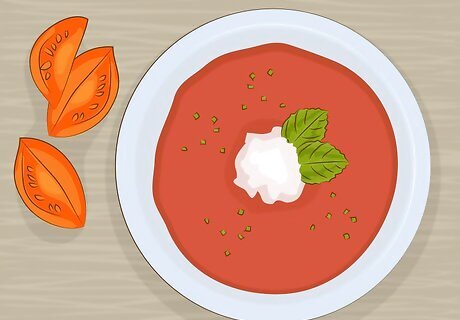
Put it in soups and stews. Oregano is a spicy and robust herb that you can use to add tons of flavor to any soup or stew, including tomato soup, vegetable soup, chicken soup or stew, beef stew, potato soup, or fish stew.

Spice up your beans. Mexican oregano is a variety of oregano that has more citrusy notes, and this pairs extremely well with beans of all types. You can add 2 tablespoons (3 g) of fresh oregano to any bean dish, including baked beans, taco or burrito filling, hummus, falafel, and bean soups.

Season fresh or cooked vegetables. Vegetables and oregano are a classic combination, and you can use a single teaspoon (1.8 g) of dried oregano to spice up salads, roasted vegetables, steamed vegetables, or even veggie dips. Simply sprinkle the oregano on before serving, or stir the herb into your favorite dips. Certain vegetables go even better with oregano than others, including tomato and eggplant, making oregano and excellent herb for ratatouille. For raw vegetables, oregano is best when paired with salads that have strong ingredients, such as olives, citrus, goat cheese, and anchovies.
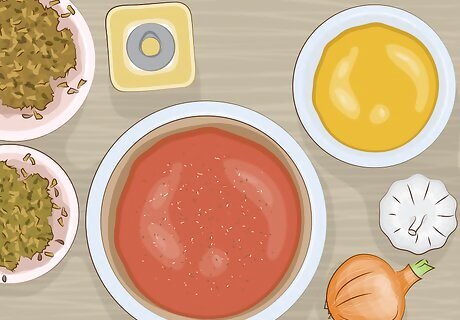
Make a Greek salad dressing. Greek dressing is an excellent way to use oregano, because it pairs the herb with a number of complementary flavors, such as olives and goat cheese. To make a delicious and versatile Greek dressing for salads, potatoes, and other vegetable dishes, whisk together: 6 cups (1.4 L) olive oil ⅓ cup (48 g) garlic powder ⅓ cup (29 g) dried oregano ⅓ cup (29 g) dried basil ¼ cup (24 g) pepper ¼ cup (75 g) salt ¼ cup (36 g) onion powder ¼ cup (62 g) Dijon-style mustard 8 cups (1.9 L) red wine vinegar
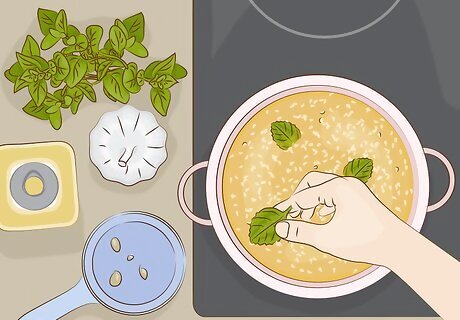
Infuse oil with oregano. Oregano-infused oil is a spicy oil that can be used for cooking, dressings, drizzles, marinades, dipping bread, and anything else that you'd use plain oil for. To infuse oil with oregano: In a small saucepan, combine a cup (235 ml) of oil, 5 cloves of minced garlic, and 3 sprigs of fresh oregano Cook the mixture over low heat for 30 minutes Remove the pan from the heat and allow the oil to cool Strain out the garlic and oregano Transfer the oil to an airtight container and refrigerate it for up to a month
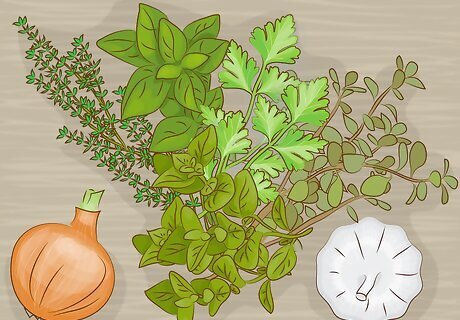
Pair oregano with other spices. Oregano doesn’t have to be used on its own, and it actually complements a number of other herbs and spices very nicely. Some of the best and most popular spice pairings with oregano include: Parsley Basil Thyme Garlic Onion Marjoram


















Comments
0 comment